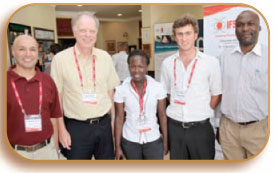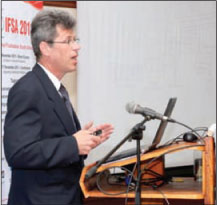Serviços Personalizados
Artigo
Indicadores
Links relacionados
-
 Citado por Google
Citado por Google -
 Similares em Google
Similares em Google
Compartilhar
Journal of the Southern African Institute of Mining and Metallurgy
versão On-line ISSN 2411-9717
versão impressa ISSN 2225-6253
J. S. Afr. Inst. Min. Metall. vol.112 no.6 Johannesburg Jun. 2012
SPECIAL ARTICLES
SPOTLIGHT
IFSA 2011 - Industrial fluidization South Africa
Sustainable development, as an ideal and as practised, is increasingly shaping the way companies do business. The MMSD Project defined it as the goal in 'integrating economic activity, with environmental integrity, social concerns, and effective governance systems.' In two of these areas-in the economic viability and the environmental impact of industrial processes-sustainability is realized, in large measure, by the type of technology employed. One technology taking up the challenge uses the process of fluidization to achieve its ends. It was the many and diverse successes of the application that prompted the organizing committee of IFSA 2011, a conference on industrial fluidization held every three years, to choose for the conference the alliterative theme 'supporting sustainable strategies'.
One of the sessions lent itself to the conference theme. Three of the papers in that session appear in this issue of the Journal. 'Clean coal and renewable energy' are issues that lie at the heart of one area of concern occupying the efforts of governments, especially those in the First World. Research endeavours in many countries are exploring ways to reduce emissions of CO2. In South Africa energy is a pressing concern: Eskom is 'managing a tight power system', the existing power stations are not meeting demand, and the price of electricity has started to and will continue to climb. The outcome of this trend is an economy in which industry finds its operations compromised and its profitability pinched. The papers presented in the first session at IFSA 2011 describe some of the solutions being considered and tested. A technology showing promise is oxy-fuel combustion, where oxygen is mixed with recycled flue gas rather than air-which dilutes the flue gas with nitrogen. Oxygen concentrates CO2, making it easier to separate. Two projects underway in South Africa plan to build power stations that will burn discard coals and meet air-quality regulation requirements without back-end flue-gas-cleaning equipment. Circulating fluidized beds (CFBs) drive all these processes. Besides running with lower emissions (compared with pulverized-fuel boilers), this technology offers fuel flexibility: CFB boilers burn coal, biomass, sludge, and process residues. In some applications processes are being carried out in combinations of fluidized beds, which allow reactions to be separated and the impact of products on the environment thereby mitigated.


The role of fluid-bed technologies in realizing sustainable solutions extends into novel developments. Professor Ruud van Ommen of Delft University of Technology, for example, in a keynote address, outlined 'how nanopowder fluidization can yield a large contribution to sustainable energy solutions'. Fluidized beds also play a crucial role in many metallurgical processes. Three papers on this subject appear in this issue of the Journal, two of them in processes that have been around for decades, one of them in a novel application that may push the envelope of pyrometallurgy to lower ('elevated') temperatures.
The conference ran over two days. It was preceded by a short course on concepts in industrial fluidization. Eighty two participants attended the day-long short course, which covered eight topics from fundamental concepts to different applications of fluid-bed technologies. There were 76 delegates at the conference. Almost a fifth of them hailed from institutions in Europe, North American, Australia, and the Far East. Most of them presented papers, which pushed the fraction of papers from international speakers to almost two thirds of those presented. This statistic reflects, in part, the priority accorded the study and practice of fluidization in this country. None the less, local delegates had much to learn from their counterparts working overseas-much to learn, that is, about the research questions being formulated and addressed, novel techniques being applied to measure and understand phenomena in fluidization, and the application and value of fluid-bed technologies in different contexts.
The conference was held for the second time at Glenburn Lodge, a short drive west of Johannesburg. The venue has much to commend it. Nestled in a forest on the banks of the Blaauwbank and Crocodile rivers and watched over by the Zwartkops mountains, it is a quiet place away from the hurly-burly of the city. This peaceful setting also has a long history. Glenburn lies in the Cradle of Humankind, one of eight sites in South Africa granted World Heritage status by UNESCO in 1999. The hominid history and significance of the area was highlighted in an entertaining talk by Dr Mandy Esterhuysen, Senior Lecturer in the Department of Archaeology at the University of the Witwatersrand, at the conference dinner at the Cradle Restaurant. In a sense the setting rounded off a conference addressing an aspect of sustainability. As the editors noted in the preface to the proceedings, it was perhaps 'fitting that we (the delegates) should meet in conference at a place of great human significance on matters of industry and its role in our future.'

P. den Hoed
Chairman, Organizing Committee














